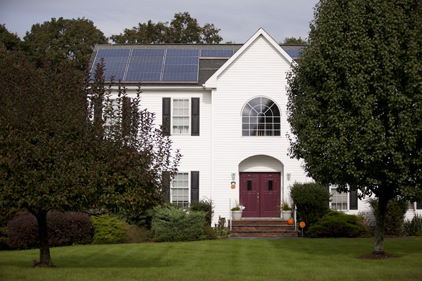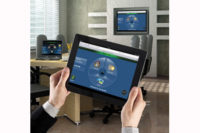
|
| Photo Courtesy of Vivint Solar |
Many integrators have already discovered that adding home energy management features to residential systems provides opportunities for additional sales and recurring monthly revenue (RMR). For those integrators looking to go beyond thermostat and lighting control, there’s new opportunity on the horizon in the energy sphere. Growing acceptance of third-party financing, or solar-as-service, options is making solar more affordable than ever to the consumer. Homeowners in a growing number of states are eager to save money and become more energy efficient via solar energy, and they are looking for someone to provide those services. Integrators may discover that they are in the best position to do so.
“When someone makes the decision to do solar, they are making a conscious decision about energy use and to do something about it,” says John Bringenberg, president of SunTalk Solar, based in Denver, Colo. SunTalk Solar emerged in 2009 as a sister company, specializing in solar, to home integration company HomeTalk.
Historically, homeowners who were interested in reducing their carbon footprint or lowering their energy costs through solar energy have steered away from it because of the high upfront costs of purchasing a system. Even though the average cost of a residential system has declined, from $34,176 to $30,545 last year, according to the “U.S. Solar Market Insight: 2012 Year in Review Report” by GTM Research and Solar Energy Industries Association (SEIA), that still exceeds what most homeowners are willing or able to spend. Third-party financing options, such as leasing of power purchase agreements (PPAs), allow customers to enjoy the benefits solar energy with little or no upfront cost. Leasing programs allow homeowners to spread their costs over time. With PPAs, the third party owns, monitors and maintains the system and the homeowner agrees to purchase the power produced by the system, usually at a rate lower than available from the local utility.
“That's the key point: solar-as-a-service allows people to pay for power as it's produced, so there's no investment in hardware, and they get what they really want — affordable, clean energy,” explains Alison Mickey, public relations and corporate communications manager for San Francisco, Calif.-based Clean Power Finance, a financial services and software provider for the solar industry and capital markets that connects solar professionals with solar financial investors.
“Solar-as-a-service has, without a doubt, dramatically expanded the market for residential solar,” says Mickey, adding that research shows that approximately 75 percent of all solar sold in the United States today is sold as a service (as a lease or PPA).
The solar-as-a-service market is being driven by the investments of large financial institutions attracted by government incentives.“State and federal tax incentives, namely the federal 30 percent Investment Tax Credit (ITC), have been key growth drivers of residential solar installations. Renewable Portfolio Standards (RPS) in some areas require utilities to generate a certain portion of their electricity from renewable sources like wind and solar. Northern California's solar rebate program has been so successful that it is no longer needed — the market is robust enough to survive without it,” says Mickey.
As solar-as-a-service options makes solar power more affordable,consumers will be looking for someone who can tie it into their home system. “Solar can be viewed as another technology in the home that needs to be integrated,” Bringenberg says.
Manufacturers that integrators already work with are starting to offer options to add solar to their home energy management services. “Usually customers who are interested in energy are naturally interested in solar,” says Alison Slavin, vice president of product management, for Alarm.com, located in Vienna, Va. Alarm.com integrates rooftop solar solutions in the Alarm.com interactive services platform to give consumers the ability to see their home’s energy production compared to their energy usage and activity.
“The end user sees the kilowatts hours used as well as dollars and cents in real time and how they are trending over time,” says Slavin of the Alarm.com Energy Monitoring Solution announced at ISC West in April. Alarm.com has recently partnered with SolarCity, a nationwide provider of solar energy systems based in San Mateo, Calif., and is actively working to partner with a number of other solar providers, she says. “We see our solution as tying in together the entire connected home ecosystem,” explains Slavin.
Going forward, the third-party residential solar market is forecast to continue its growth, and according GTM Research and SEIA’s report, it will become a $5.7 billion market by 2016.
The market will continue to expand as more states adopt solar-friendly policies, explains Bringenberg, “It’s a growing thing. Now a couple dozen states, but ultimately it will be all 50 states.”
Builders are interested in solar as well, says Bringenberg of SunTalk Solar, which works primarily in providing solar installations for new construction. He explains that they like solar because, unlike insulation with higher R-values or more efficient HVAC systems, it is a salient way to emphasize the energy efficiency of the homes they build. “That is a very visible signature on the house that they have done a good job on energy efficiency,” Bringenberg shares. Slavin agrees: “Homes with solar on the roof sell at a premium.”
Dealers can attain many benefits from offering solar. “Solar tends to be a higher revenue per sale than typical AV and smart home solutions,” Bringenberg believes. However, he notes that the margins tend to be lower because in solar friendly states incentives attract more companies, making the market more competitive.
Providing solar solutions can also be a way for integrators to differentiate themselves from their competition in the home integration market. Bringenberg explains that solar was a good fit for their company’s philosophy. Whether installing rooftop solar systems, mounting televisions with energy saving features activated, or dimming the lights, he says: “We incorporate an energy attitude across everything we do.”
Offering residential solar can be a good fit for integrators because many aspects of the solar business fit well with what they already do.“Security and home technology integrators have the skills and the opportunity to make solar a significant part of their businesses: they have electrical training, or they're in people's homes selling services every day. Most importantly, security and home technology integrators are used to selling homeowners a value-added service — the difference with solar services is that they reduce homeowners' current expenses,” Mickey explains.
Companies that offer security, home automation, and energy management solutions have an edge in marketing as well. “Cross-selling consumers is a huge opportunity,” she adds.
Bringenberg points out the advantage of being a hybrid company means security and home automation integrators have a built-in customer base for selling solar. He estimates that dealers could see 5 to 10 percent of their existing customers opt to add solar.
He does caution dealers about one aspect of marketing solar. As the cost of solar goes down, incentives provided by local utilities go down, so dealers have to retool their pricing, about every six months, Bringenberg estimates. “You quickly become savvy to it, but you have to be prepared and rework your business metrics one or two times a year to keep up with changing incentives,” he advises.
Dealers looking to enter the solar market can start by affiliating with large national leasing companies. They should identify what strengths they can leverage and what assets they need to acquire, such as pursuing appropriate certification and training, exploring options to fill necessary skill sets (e.g. hiring or partnering with licensed electricians), and obtaining necessary tools and equipment.
“Vivint is a great case study of how dealers and integrators can get into the solar sector,” says Mickey. Vivint’s solar division, Vivint Solar, leverages the company’s experienced sales and service staff and other assets to add solar as a complement to their existing offerings (Read more about Vivint Solar in SDM’s profile of the company.
While offering residential solar solutions may not be right for every dealer, given the opportunities presented by this growing market, it may well be worth looking into for some. Companies doing business in states with solar-friendly policies or in markets where energy costs are high will find the most opportunity. As energy costs rise, governments, utilities and consumers will be looking for new alternatives. “Managing our natural resources for energy is one of the most important things we will have to wrestle with for decades. [Dealers] getting into solar will have a very long life,” Bringenberg says.
With continued growth in the residential solar market expected, now may be the time for integrators to consider adding this to their portfolio of offerings.
Mickey shares, “Bottom line, this is what you do now. You sell services — but the value proposition of solar-as-a-service is even more compelling than what you sell today. Anyone can do this. It sounds new and complicated — ‘third-party residential solar financing’ — but it's literally the same idea as plain old service contracts, just with a fancy new name.”
Additional solar information:
For information about the solar industry, visit the Solar Energy Industries Association (SEIA) website at http://www.seia.org.
To learn more about certification and standards for solar professionals, visit the North American Board of Certified Energy Practitioners (NABCEP) website at www.nabcep.org.









